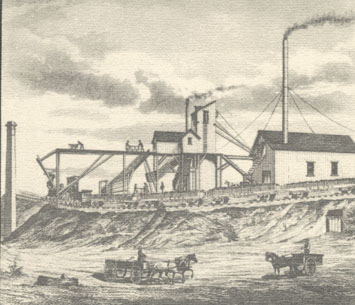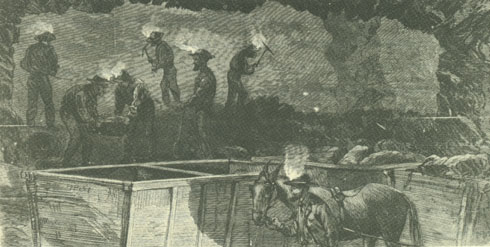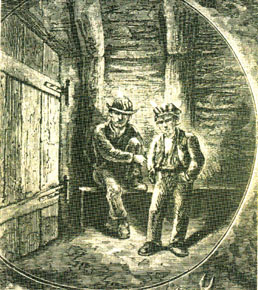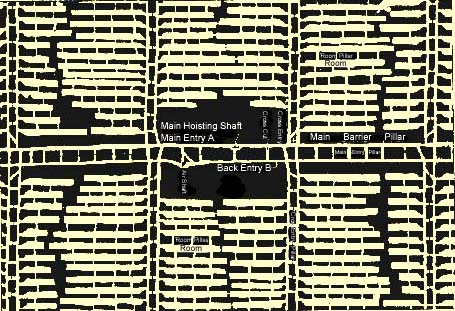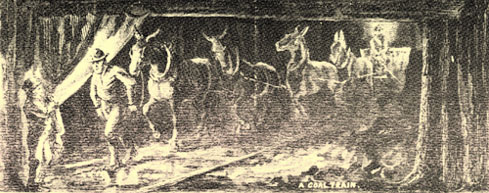A TOUR THROUGH AN
ALBIA COAL COMPANY MINE From: The History of
Monroe County, Iowa |
|
The surface of Monroe County is almost entirely underlaid with a layer of coal, varying from three or four inches to twenty-two inches. Farmers in many places find small deposits, which enable them to strip out wagon loads of poor grade coal, which they sell to the people of Albia. They are able to carry on a limited system of trade as farmers in timbered regions do with wood. The real source of wealth to Monroe County is the excellent grade of coal produced by organized companies. These companies within the county produce at least 500 tons daily, on the average. There are from 600 to 800 men working in the business most of the time. The writer visited the Albia Coal Company's mines, and, at the invitation of one of the owners, inspected the mine operation. The mines cover an area of 480 acres, and are located on the main line of the C. B. & Q. R., about three miles west of Albia.
Three trains daily carry the loaded cars from the side tracks, and shipping facilities are all that could be desired. A little village has grown up in the neighborhood of the mines. At the works we were met by Mr. Miller, the Superintendent, and shown the outer machinery. A Double-cylinder stationary engine operates the hoisting apparatus in the shaft. Over the mouth of the pit is the usual derrick for dumping the cars, and beneath the spouts a side track is laid. The above ground features of a mine are well known to all who live in the county, but it is safe to say that there are thousands here who have never gone into the actual mines. It was not without fear that we anticipated the tour of the mine. Mr. Miller announced that all was ready and the engineer placed his hand on the lever of his engine. One hundred and thirty-five feet below, in the mine, rested the cage that was to rise as the one we were in passed down into the mine shaft. The shaft is some six by twelve feet in size, divided into two sections by a partition of planks and timbers. The hoisting machinery works with a reverse motion, so that one cage ascends while the other descends. Mr. Miller stepped
boldly on the cage and told us to follow.
"Sit down low," said a voice in our
ear, and the car slid rapidly from the platform into the dark. We were in
the mine. Here the miners are at work. The blast which sounded so loudly a moment before had scattered huge masses of coal about, filling the "room" with fragments. One man was working to load the loose coal on the cars, which ran on the track at the mouth of the mine. Another man was picking into the solid wall, with a small pick-ax, cutting a trench several inches deep and six inches wide. When this was done, he intended to drill into the wall and there insert a cartridge of powder. The explosion of such mines had caused the thunders which reverberated through the mine passages. The "rooms," as the compartments were called, are worked by two men in each. The plan of the mine is like that of a town. Accurate maps are made and main streets laid out. From these, at regular intervals, passages are cut, at right angles, and massive columns of coal are left as supports for the roof. When several yards in depth are reached, the passages are widened into "rooms," as though town lots were excavated leaving a wall between. The walls are left until the mine is exhausted and then they would also be partially removed. The blocks of coal are put into cars from each of these rooms and run to the main shaft, where they are lifted to the surface of the earth and dumped into flat cars on the railway.
Mules are used to do the hauling. The smaller animals are chosen because of the limited space in the roadways. In this mine there are seven mules, which live underground. These mules become very wise. They soon learn what is required of them.
The miners get so
accustomed to their work that they often express pity for the poor fellows
who have to work in the sun. They are a world unto themselves. Ten hours
out of the twenty-four are spent in the earth, the workmen taking their
dinners with them into the mine. They are paid by the amount of coal
mined, not by the day. As a general thing they are a hardy, healthy class. Explorations in Iowa History Project |
